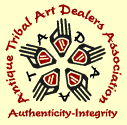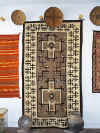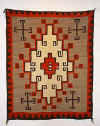A Brief History of Navajo Blankets & Rugs
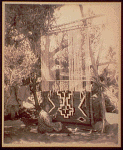
In the 16th century, when the Spanish arrived and subsequently conquered the peaceful pueblo Indian cultures of
what is now New Mexico and the American Southwest, the Navajo or Dine peoples which then lived north of the pueblos were
seldom if ever seen by the Spanish and known mostly through the Pueblo Indian stories and encounters (often stories of
raids by the Navajo on the pueblos) related by the Pueblo tribes.
The Navajo--who may have come together as an amalgamation of several tribal and clan cultures
of the Southern Plains to form their own
distinctive culture less than one hundred years before the Spanish Conquest-- are linguistic relatives (Athapascan) of
the Apache and are generally considered to have had, in the16th century, a culture more similar to Plains nomadic
hunter-raiders than to the Pueblo sedentary-agrarian cultures.
The Pueblo tribes grew cotton and wove blankets and garments on a distinctive pueblo loom hundreds of years before
the Spanish arrived (these weaving skills perhaps brought up by Indians from what is now Mexico and Central America),
yet it was the Spanish who first introduced sheep to the Southwest.
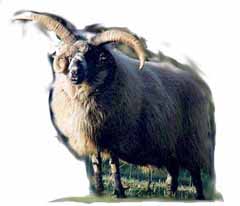 |
The earliest sheep brought to the Southwest by the Spanish was the churro, a
small sheep with very long silky, smooth stapled wool perfect for weaving and in a variety of natural shades: dark
brown, tan and cream. Rarely used today, despite many breeding attempts, the churro's few modern descendants seem to
lack in their wool the length and silkiness, sheen and feel that distinguish the pre-1900 breed. (Photo: modern, shorter
wool "churro") |
Upheaval of the Pueblos
Harsh persecution of pueblo peoples and the destruction of traditional pueblo culture by the Spanish led to the
Pueblo Rebellion of 1680. It was during this turbulent period and Diego de Vargas 1692 Re-Conquest that Pueblo Indians
escaping retaliation for the rebellion lived among the Navajos and introduced both sheep and weaving technology to the
Navajo to a degree such that written records among certain Spanish documentation , covering a period from 1706-1743,
records the Navajo keeping sheep and weaving wool blankets during that period.
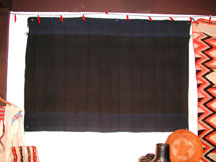
Pueblo manta, late 19th century
The earliest known surviving examples of Navajo blankets are but fragments dating from the 1805 Massacre Cave site
near Chinle, Arizona and Canyon de Chelly. At this site more than one hundred elderly men, women and children were
slaughtered by Spanish slave traders. The fragments show simple, conservative Pueblo Indian-influenced designs of narrow
banding in alternating colors of natural sheep wool tones (white, grey, brown, tan, black) and some vegetal dyes (mostly
shades of rust, yellow and green). Indigo blue dyed wool yarn was also found among the fragments. Indigo was obtained by
the Navajo from Mexican pony caravans coming up from Mexico City.

Mexican Indigo-dyed Saltillo Serape, c. 1875
The oldest Navajo weavings available to the collector's market can sometimes be dated back to the 1870's or 1860's to
a time of transference out of Navajo hands. How old a weaving may have been at time of transfer and beginning of a
recorded history is usually unknown. Weavings dated earlier than this time are usually estimated based on style, dyes
and ravelled materials used and compared and contrasted with known dated weavings and their dates often broadly
estimated (eg. "1800-1860" or "pre-1860") as more specific dating may be impossible at present time.
Navajo Blanket & Rug Periods
- Classic Period (1700-1850)
- Late Classic Period (1850-1868)
- Transition Period (1868-1890)
- Rug Period (1890-1930)
- Regional Style Period (1930-Today)
Other important dates include:
- Chemical (Aniline) dyes invented in England (1856)
- Aniline dyes transported to Southwest by Santa Fe RR (1865)
- Three ply dyed yarn transported to SW from Germantown, Pennsylvania textile mills by Santa
Fe RR (1865 approx.)
- Four ply dyed "Germantown" yarn (by 1875)
The collectibility of rare and early Navajo Blankets has long attracted the wealthy and celebrated collector from
William Randolph Hearst --who over a period of a decade or so before 1920 collected more than 200 important 19th century
Navajo blankets-- to the leading actors, filmmakers, recording artists , politicians and business tycoons of today who
seek similar items.
Today, anyone who has an interest in decorating their home or office in historic weavings can find examples to fit
every budget and every display purpose.
Chief's Blankets
Prior to the trading post era when the Navajo learned to make rugs
for the American resale trade, the Navajo wove only blankets -- both for themselves and for trade with the Spanish and
with other Native American Indian tribal cultures.
Blankets were woven in several sizes but three major forms: serape (a shoulder blanket that is
woven longer than wide), saddle blanket (in single form a squarish small weave or in double saddleblanket form to be
folded in half under the saddle for extra cushioning), and in chief's blanket form.
A chief's blanket is a shoulder blanket woven on the loom wider than it is long -- the ONLY
Navajo weaving to be woven this way--(even later Navajo yei rugs , made to be displayed hoizontally, were woven
vertically on the loom)-- and the design often joining up to form an enclosed pattern when properly worn wrapped around
the body as a shawl and usually held in place with the hands or with a pin of some form.
Serapes continued to be made throughout all of the 19th century as well.
*******
 
Navajo shoulder blanket forms: chief's vs. serape
Left: A Germantown Chief's Blanket of Third Phase Pattern
Right: A Homespun Transitional Blanket, Serape form.
Any shoulder blanket woven (when on the loom) longer than wide is a
shoulder blanket form referred to as a serape. Note that while the serape is
worn on the shoulders horizontally as shown in photo, it is woven on the loom
vertically, unlike the chief's. Many Navajo blanket collectors prefer to display
shoulder blankets as they would have been on the loom, so if not displayed on a
mannequin, serapes are usually displayed vertically.
To determine how the blanket was woven on the loom , look at the direction of the warp cords
(the interior "skeleton" of the blanket) which will appear as tiny continuous ridges on the exterior of the
blanket for the entire length of the blanket.
*******
"Chief's blanket" is something of a misnomer as the Navajo did not have
"chiefs" within their social structure. The term came to be used because only a relatively wealthy person
(such as a chief in a Plains Indian tribe or the Utes who especially liked and traded for these weavings) could afford
the extravagance and cost of these beautiful weavings.
Phase 1 --Pre-1850
"First Phase" or "Ute -style" blankets of the
pre-1850 "Classic" Period were simple banded chief's blankets with broad horizontal bands of natural dark
brown/black alternating with broad bands of creamy white churro sheep wool yarn, often with narrow or broad bands of
indigo-blue dyed yarn and sometimes red bands obtained from ravelled yarn (the unravelled and re-twisted threads
obtained from bolts of trade cloth, especially the cochineal insect red-dyed English baize trade cloth, known by the
Spanish as bayetta.)
Phase 2 -- 1850-1860
Second phase chief's blankets of the "Late Classic" Period . Smaller design elements, often small
rectangular elements were placed within one each of the top, middle and bottom horizontal bands , often in a
twelve-position layout. The effect was that the new elements were being placed "on top of" the traditional
Phase One motif, with the First Phase blanket now a "background".
Phase 3 -- 1860-1868
The new elements now expanded beyond the bands, and were laid out in a "nine -spot" design with three
elements each across the top, middle and bottom of the old Phase One pattern. The new elements could be squares,
rectangles or diamonds, and in some later interpretations --especially during the Transition Period-- became so large
that the original Phase One pattern of bands can barely be discerned. Some of these latter interpretations are sometimes
referred to as "Chief's Variants."
Chief's Blankets of the Transition Period (1868-1890)
Chief's Blankets, especially in the Third Phase form most desired
by collectors of that time, continued to be made past the Late Classic Period and into the Transition Period. The major
differences being the substitution of aniline-dyed yarn for ravelled yarn, and the decrease in the use of indigo dye,
being replaced by aniline purple-blue dye. While not as rare nor as costly as Late Classic period weavings, Transition
Period Weavings -- whether in homespun yarn or Germantown trade yarn-- (today regularly sold at a fraction of the price
of Classics), offer weavings over one hundred years old that capture much of the beauty of the earlier weaves and often
greater complexity in both color and motif and often were woven by women who would have also been weaving during the
Classic period.
"Chief's - Style" Rugs after 1890
The "Chief's Pattern", especially the Second and Third Phase pattern, continued to be
used after the Transition period and is even found in modern "Revivals". These heavier pieces, more rug than
blanket, each reflect the time period in which they are made. Third Phase Chief's rugs made prior to 1930 can in some
instances maintain many of the blanket-like characteristics of the earlier weaves and can sometimes be quite sought
after and collectible, often priced similarly to the best regional style rugs of the same size and period.
After 1930, however, there is little intrinsic value to a rug having a "Chief's
-influenced" pattern or design. |

